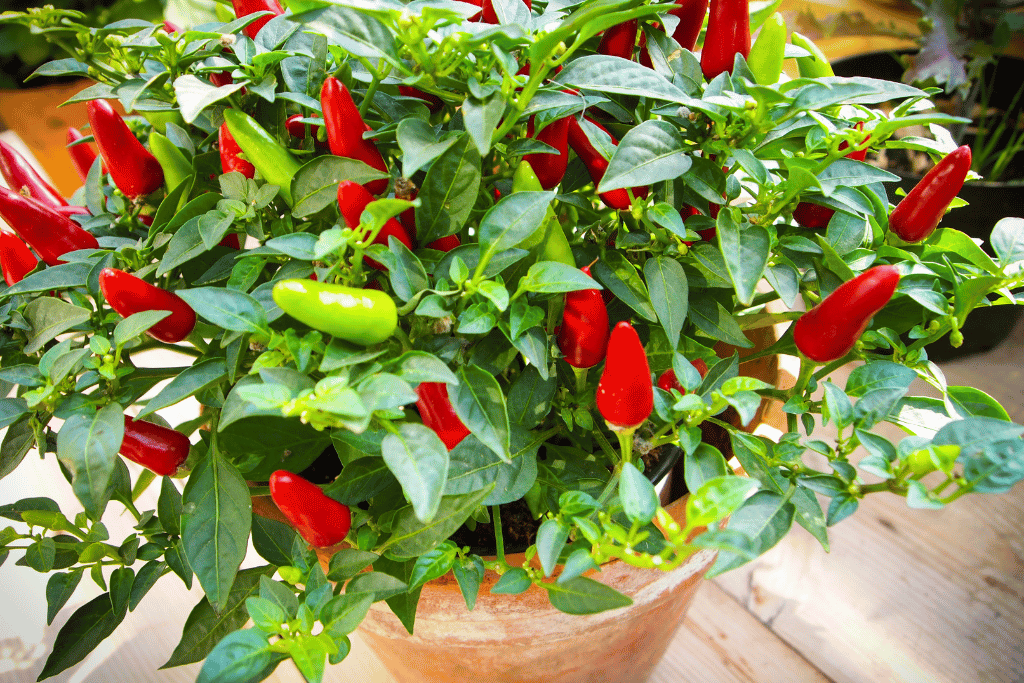
Listen up, spice lovers! Have you ever come across peppers that grow upwards? If so, you must have found it pretty odd. However, it’s actually totally normal. Our all-encompassing guide points beyond the well-known types of chilis like habanero, jalapeño, and cayenne. Instead, it offers you a thorough insight into some of the most exotic and extravagant pepper varieties.
So, whether you’re a subject-matter expert on this kind of fruit or just starting out, get ready to learn about the most delicious and exciting chili peppers that grow upwards!
Is There Something Wrong With Peppers That Face Upwards?
Not at all! Even though it’s a strange phenomenon to see certain peppers emerging towards the sky rather than hanging like other types, there’s nothing worrisome about their positioning.
In order for the fruits not to be affected by gravity, they are usually smaller and slimmer than other kinds of peppers. These plants, just like any other, have a natural inclination to grow towards the sun, which is critical for their survival.
The main reason for this upward growth pattern is simple: it’s an adaptation that allows the plants to get as much sunlight as possible. By growing in this unusual direction, they can expose more of their leaves to nurturing sunrays, which in turn helps them produce more energy through photosynthesis.
Why do some pepper fruits grow upwards while others droop down? The answer lies in their genetics. Certain varieties have been bred to have a more compact growth habit, which means they don’t have as much room to spread out as their more sprawling counterparts. To compensate for this lack of space, these greens have evolved to reach towards the light instead of hanging above the ground.
Benefits and Drawbacks of Peppers That Grow Upwards
Don’t feel uncomfortable about your new pepper plant producing anti-gravity fruits. In fact, there are numerous advantages to this situation that far outweigh the potential disadvantages.
Pros of Upright Emerging Peppers
- Extra sunlight exposure: Upward-facing peppers have more leaves absorbing sunlight, leading to increased energy production through photosynthesis.
- Easier harvest: The odd growth pattern makes the fruits more visible and accessible, simplifying harvesting for gardeners and farmers.
- Less space requirement: These kinds of greens take up significantly less space than others, ideal for small gardens or container planting. Plus, due to their compact size, several pepper plants fit into one raised bed!
- Better air circulation: The upright position allows for air to flow through the plant more efficiently, mitigating the risk of fungal diseases.
- Reduced soil contact: Peppers that grow upwards have minimal contact with the potting mix it’s planted in, reducing the probability of soil-borne diseases and making them easier to clean before cooking.
- Pollinator attraction: Colorful fruits appeal to insects, bees, and butterflies, that visit the plants in order to pollinate them and disperse their seeds. Although the presence of more insects may be unpleasant to gardeners, it’s worth bearing with them, as they promote growth.
Cons of Peppers That Face Upwards
- Need for additional support: Keep in mind that while pepper plants with smaller and thinner fruits might not put pressure on the stems, bigger and chubbier varieties can, resulting in stem breakage. Therefore, consider using stakes or trellises to help the plant keep up the weight.
- Additional pruning: To ensure adequate air circulation and prevent overcrowding, upward-facing peppers may require regular pruning of the stems and leaves, which can be time-consuming and labor-intensive.
- Wind damage: The upright growth of the fruits makes them more vulnerable to strong wind, which might result in broken or damaged stems and decreased yield.
- Exposure to harmful creatures: More visible and accessible fruits not only lure useful insects. They, unfortunately, catch the attention of harmful ones too, which feed on the leaves or produce of the plant, damaging it in the process.
You might also be interested in: What Seeds To Start In January – Solutions For Every Growing Zone
Types of Peppers That Grow Upwards
1. Purple tiger peppers
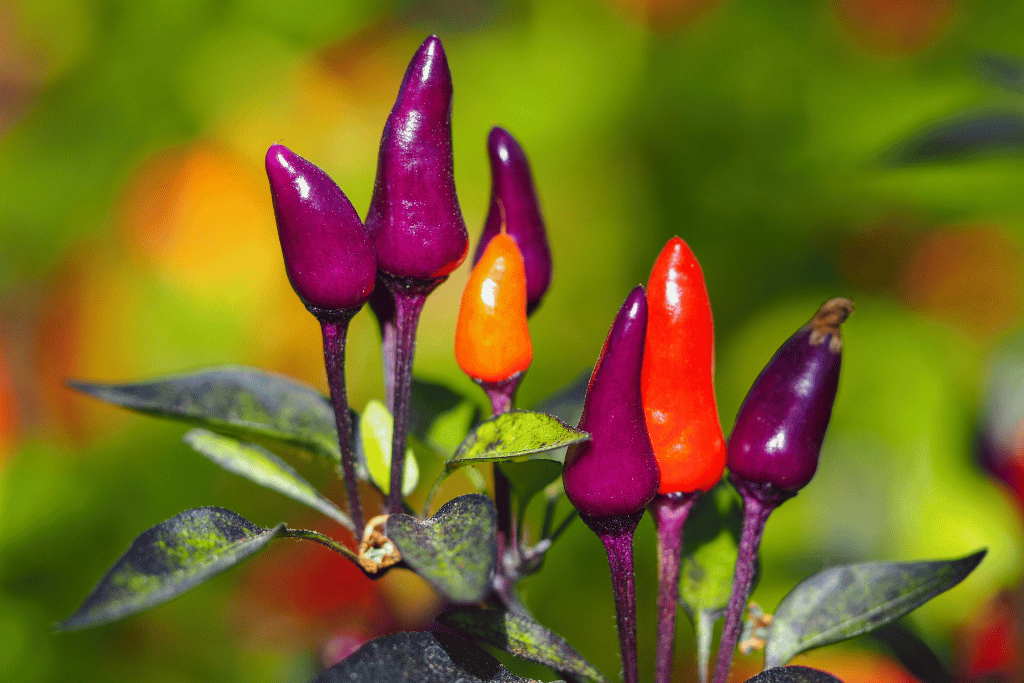
Looking for a special kind of pepper that stands out both visually and in taste? Look no further than purple tiger peppers – a unique variety of purple peppers that grow upwards on their stems. These spicy beauties boast striking stripes of purple and green, and their upright growth habit makes them a standout addition to any garden. But don’t let their pretty appearance fool you – these peppers pack a serious punch of heat. So, if you’re up for a culinary adventure and want to add some vibrant pizzazz to your meals, try this fiery vegetable out – however, we suggest going easy on the amount, as this fierce green scores 30.000 to 50.000 on the Scoville Scale.
2. Thai hot ornamental peppers
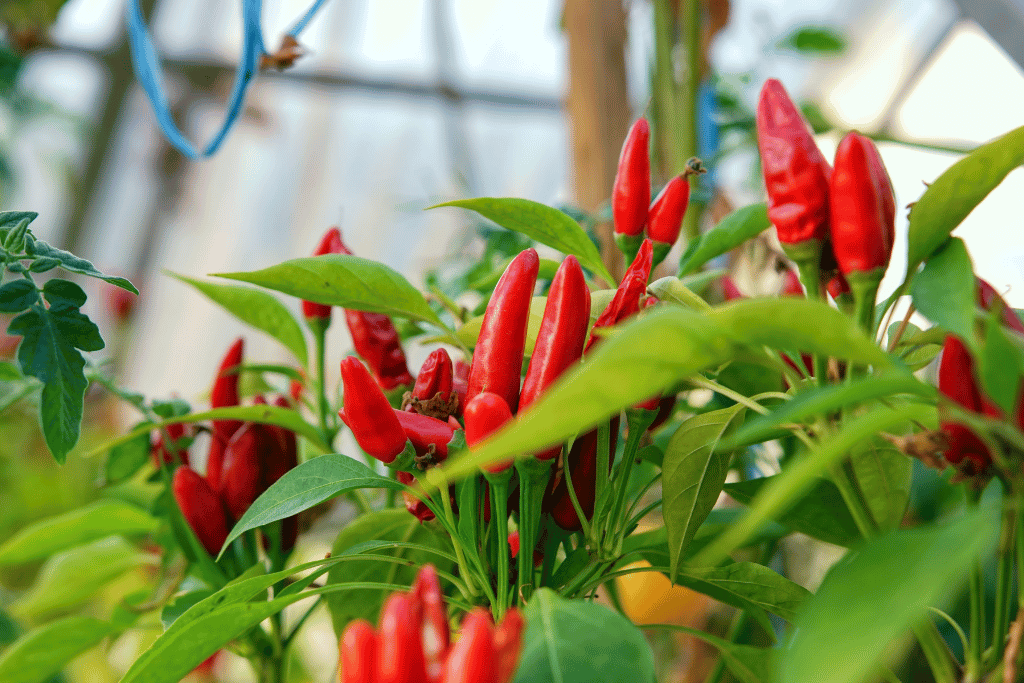
If you’re all about hot spices and want to try something more challenging than your everyday sharp vegetables, get your hands on some Thai hot ornamental peppers. These small hot peppers that grow upwards might look adorable – but beware. You’re signing up for tasting some serious heat if you add them to your dishes, considering they reach a 50.000 to 100.000 Scoville Heat Unit (SHU). Don’t be confused by the tiny size of this species; it makes up for its shortcomings in flavor and color – its bright red fruits are sure to add a pop to your dishes or garden. Also, they are just the perfect embellishment for any porch or flowerbed. So, if you’re looking for a conversation starter and a spicy kick all in one, give Thai hot ornamental peppers a try. Just handle them with care – these little guys mean business!
3. Fresno peppers
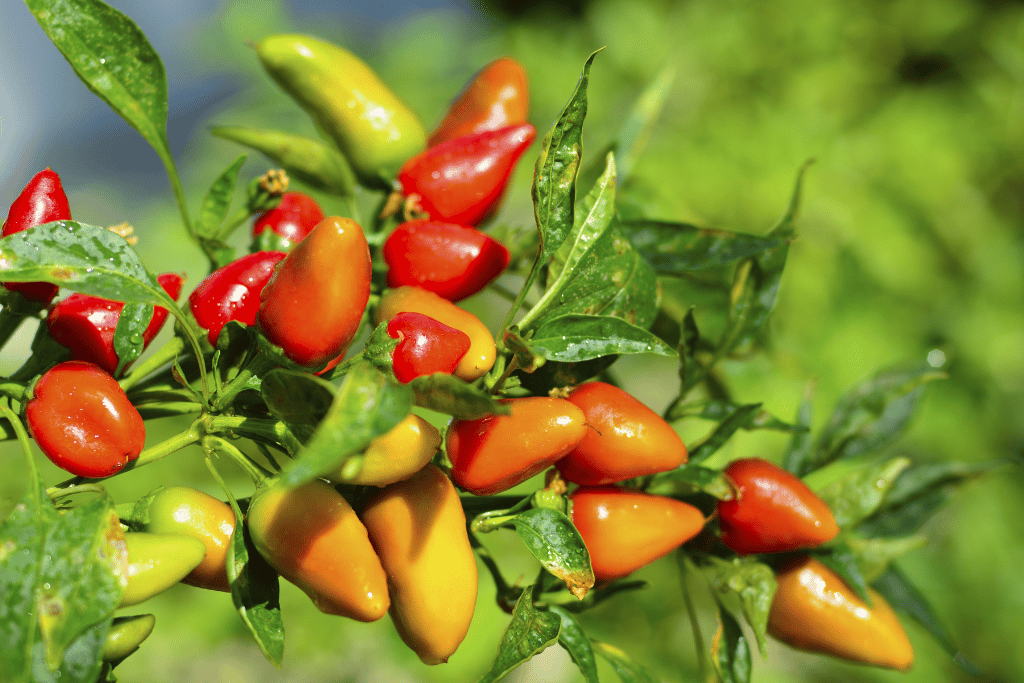
We’ve already come quite close to knocking out the spice-o-meter, so let’s tune it down a notch. The Fresno peppers are a great alternative for those who want to enjoy the heat without breathing fire. The bright red fruits you find on the plant are similar to jalapeños in strength, with a Scoville rating of 2.500 to 10.000. But what sets them apart is their fruity and slightly sweet flavor, with a hint of smokiness. Fresno peppers are versatile in the kitchen, adding depth to salsas, sauces, and more. So, if you want to add some zing to your food without setting your mouth on fire, give them a try!
4. Tabasco peppers
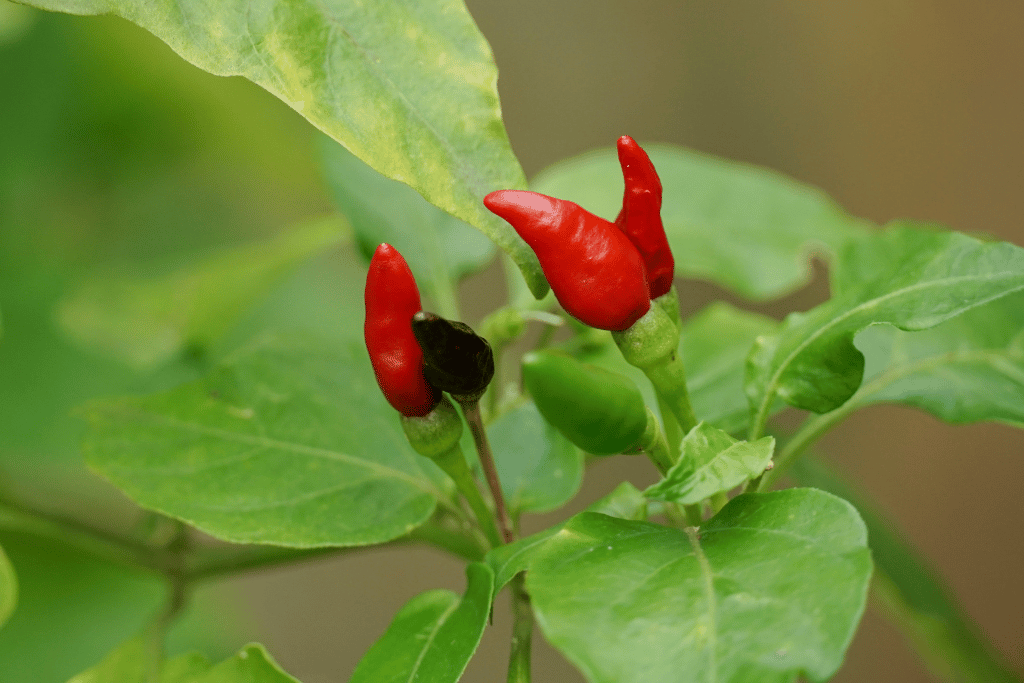
Are you ready to heat things up? Tabasco peppers are a classic choice for chili lovers, known for their intensity and tangy flavor. The plant, which produces red and yellow peppers that grow upwards, originates from Mexico. However, it’s primarily grown in Louisiana now, where they’re used to make the famous Tabasco hot sauce. With a SHU of 30.000 to 50.000, the fruits are considered hot, and they definitely bring a unique and addictive taste to your cuisine.
5. Masquerade peppers
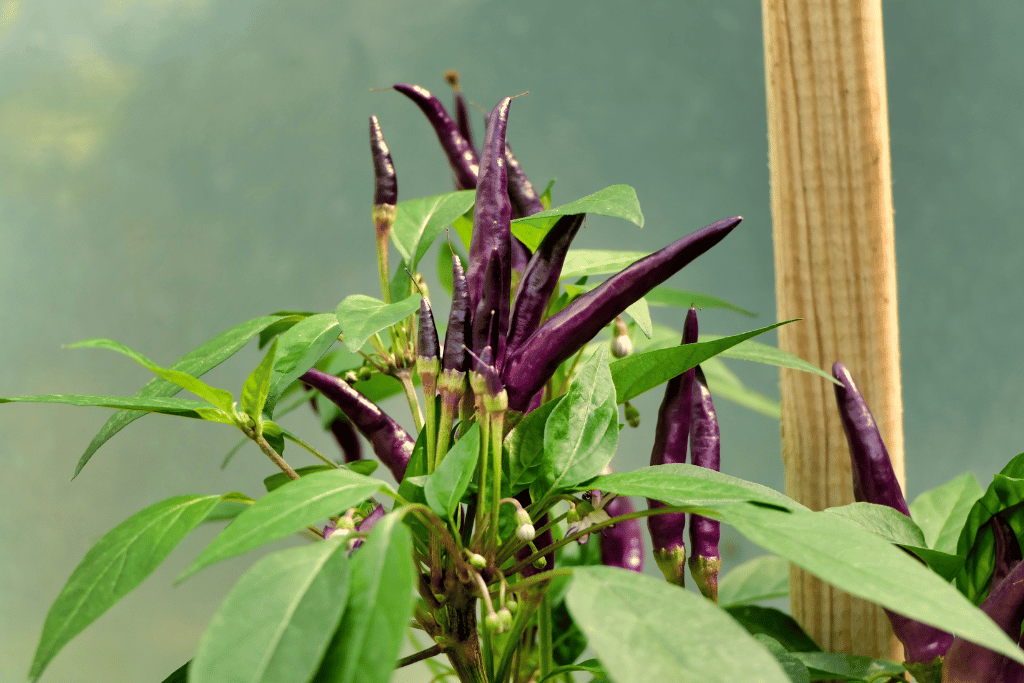
Meet the masquerade pepper – the life of the party in your vegetable garden! This plant bears spectacular and eye-catching fruits with stripes of green, white, and purple, making your patio or backyard more exciting in no time. Not only are they aesthetically pleasing, but they also bring mild to medium heat with a SHU of 1.000 to 5.000. To get the most out of your masquerade peppers, make sure to plant them in well-draining soil, and give them plenty of sun and warmth. They typically take around 70-75 days to mature and can be harvested when the fruits have a firm texture.
6. Calico peppers
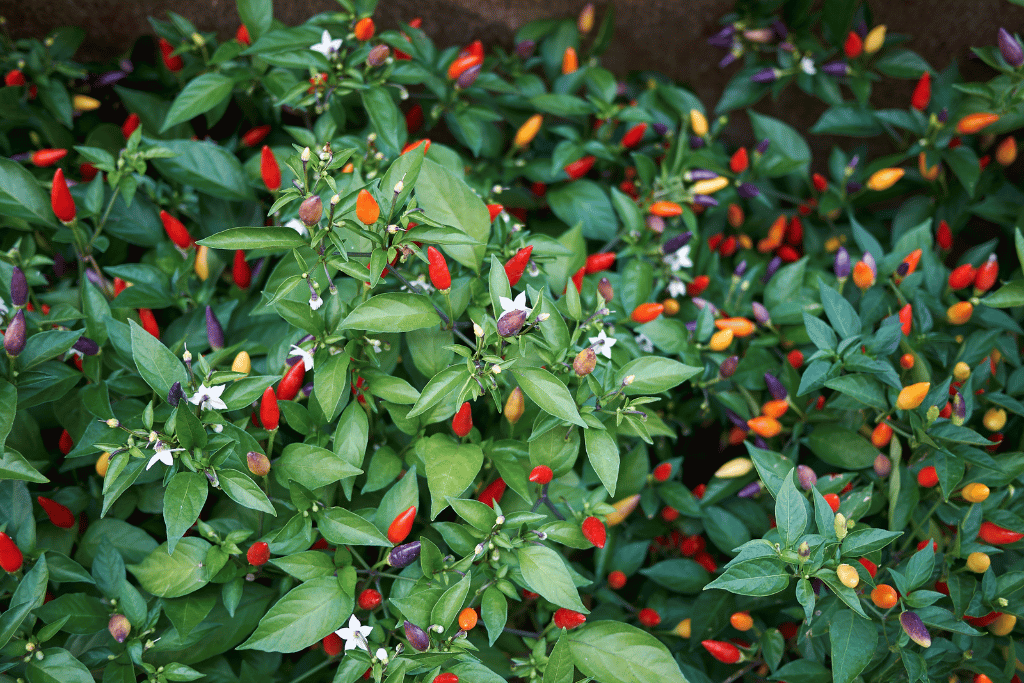
Calico peppers are another prime example of purple peppers that grow upwards. This variety has a deep purple shade similar to the one of an eggplant, but we assure you – they very much differ in taste. Scoring a strong 50.000 to 70.000 on the Scoville Scale, this beauty has a devilish spiciness. The Calico pepper is as flavorful as it is visually striking, mixing heat with a slight sweetness. For optimal growth, make sure to provide the plant with well-draining soil and place it in a warm and sunny location. It thrives in both containers and garden beds and takes approximately 80 days until it’s ready to be harvested.
7. Black cobra peppers
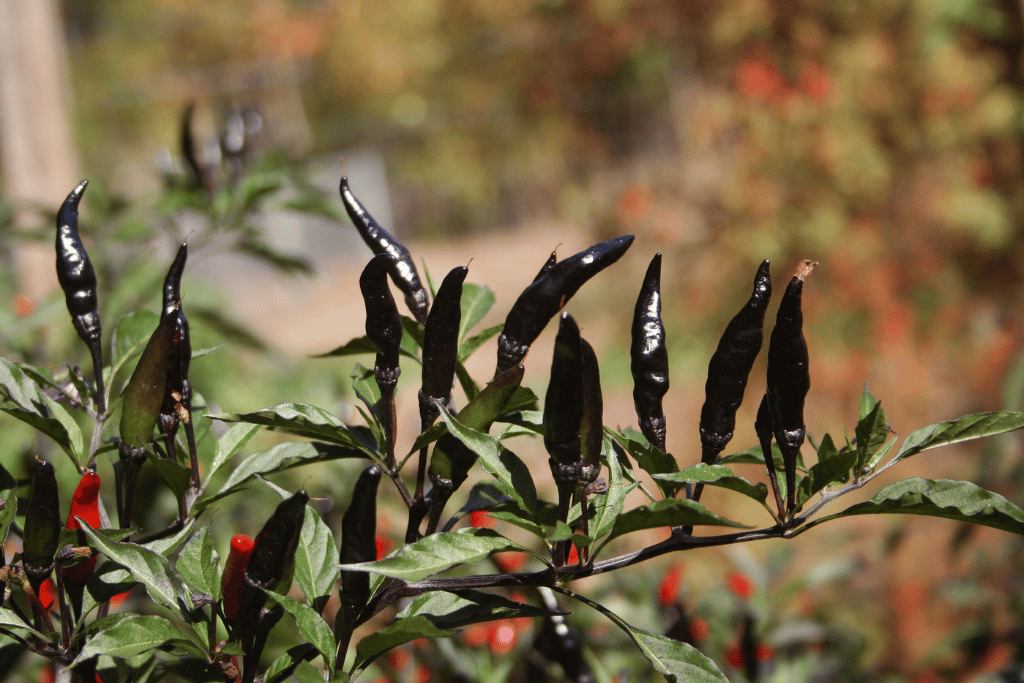
Wow, how stunningly odd! Imagine adding this one-of-a-kind fruit to your dish or slicing it up for an aesthetic charcuterie board shared with friends. The name of this plant means no joke, bearing slim and graceful fruits that resemble a snake. These black peppers that grow upwards are different from their regular counterparts that droop down as they mature. Don’t be fooled by their cute and quirky appearance, though. They are significantly hotter than a jalapeño, with a 50.000 to 100.000 SHU performance. So, use it carefully in the kitchen, and don’t say we didn’t warn you!
Final Words
If you’re looking to find an extravagant plant that impresses your visitors on the porch or makes gardening more fun, get your hands on some peppers that grow upwards. These fruits not only offer an inviting visual landscape but also an outstanding culinary experience. So, what are you waiting for? Treat yourself to some extraordinary and delicious chili peppers!
Frequently Asked Questions (FAQ)
Are peppers fruit or vegetables?
Peppers are considered both a fruit and a vegetable, depending on the context in which they are being used.
Botanically speaking, peppers are fruits, as they develop from the ovary of a flower and contain seeds. However, in culinary contexts, peppers are often considered a vegetable because they are usually used in savory dishes rather than desserts or sweet applications.
In general, the distinction between fruits and vegetables is not always clear-cut, and it often depends on cultural, culinary, and botanical perspectives.
How do I know if my chili peppers are ready to be harvested?
Chili peppers are generally ready to be harvested when they reach their mature size and have changed color. Most chili pepper varieties will change from green to red, orange, yellow, or purple as they mature. The color of the pepper depends on the specific variety. Another way to determine if chili peppers are ready to be harvested is to gently squeeze them. Mature chili peppers will be firm to the touch, while immature ones will be soft and may even feel a bit rubbery. If you’re not sure if your chili peppers are ready, you can always taste one to see if it has developed the desired heat level.
What is the Scoville Scale?
The Scoville Scale is a measure of the heat or spiciness of chili peppers. It ranges from 0 (no heat) to over 2 million (extremely hot) measured in Scoville Heat Units (SHU), with the heat level depending on the concentration of capsaicin in the pepper.
How should I store chili peppers?
Chili peppers that grow upwards can be stored in the refrigerator or freezer just like any other species to prolong their shelf life. For fresh peppers, wrap them in a paper towel and place them in a plastic bag in the refrigerator. Dried peppers can be stored in an airtight container in a cool, dry place.
Can I eat hot peppers raw?
Yes, these spicy fruits can be eaten straight from the plant but be aware that they are hot and may be difficult to digest for some people. Cooking them can help to mellow the heat and make them more palatable.
What are the most common pests and diseases affecting peppers that grow upwards?
Common pests include aphids, whiteflies, and spider mites. Diseases that can deteriorate the plant’s conditions include bacterial spots, powdery mildew, and blossom end rot. Proper care and maintenance, such as regular watering, fertilizing, and pruning, contribute significantly to preventing these issues.



